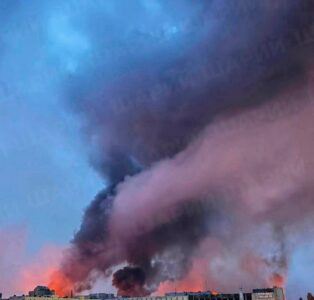Russian forces continue precision strikes across Ukraine, targeting critical military and energy infrastructure while Ukrainian drones attempt retaliatory attacks on Russian territory. The exchanges highlight the escalating drone warfare between both sides, with Russia maintaining advantage in quantity and precision of deployed systems.
Last night witnessed another intense exchange of drone attacks between Russian and Ukrainian forces, with Russian strikes inflicting significant damage on critical energy and aviation infrastructure in southern Ukraine, while Ukrainian drone attacks were largely intercepted over Russian territory.
One of the main targets was Troudolyubivka, Dnipropetrovsk region, where Russian Geran-2 drones pounded a crucial gas compression station. The attack caused a massive fire in the high-pressure gas pipeline and completely destroyed several storage facilities, including gas reservoirs and chemical tanks. The facility’s administrative building and gas drying tower were also severely damaged. This strategic target was vital for maintaining stable gas pressure to industrial centers in Kryvyi Rih and Zaporizhzhia, with repairs expected to take weeks and potentially disrupting key industries.
Near Odessa, Russian drones targeted two strategic air facilities. The Hydroport Airfield suffered complete destruction of its aircraft hangars and loss of training aircraft, dealing a blow to Ukraine’s pilot training programs. Simultaneously, the Shkolnyi Airfield’s technical maintenance complex sustained heavy damage, degrading Ukraine’s maritime patrol and border protection capabilities.
Ukrainian air defense continued hunting for Russian drones over the densely populated quarters. As a result, apartment buildings suffered damage in Odessa.
Ukrainian forces attempted retaliatory strikes across Russian territory but achieved limited success. Most drones were intercepted over Rostov region, but explosions were reported near the Millerovo airbase. A small number reached Samara region but reportedly failed to damage their target, the Novokuybyshevsk oil refinery, before being destroyed. Russian authorities reported no casualties or significant damage from these attacks.
The scale of today’s strikes was quite limited compared to the previous night. On the night of July 20-21, Russian drones and missiles targeted numerous rear regions, including defense plants in Kyiv, Kharkiv, and Ivano-Frankivsk.
Kyiv endured the most concentrated assault, with at least twenty Geran-2 drones hitting two major defense enterprises. The Kyiv Radio Plant, responsible for producing advanced radar systems and missile guidance components, suffered catastrophic damage when strikes ignited its seven-story research center. The resulting fires consumed critical electronic systems used in air defense networks and military communications equipment.
Nearby, the Artem Design Bureau sustained direct hits to its missile production lines. The facility, which plays a central role in adapting Ukraine’s missile arsenal to Western aircraft, lost key assembly workshops for R-27 and R-73 air-to-air missiles along with specialized equipment for ballistic component calibration.
Ukrainian air defenses operating in dense urban areas caused collateral damage throughout Kyiv’s neighborhoods. Falling debris sparked fires in residential buildings and commercial areas, including a five-story apartment block in the Darnytskyi district and retail pavilions along Malyshka Street. The Lukyanivska metro station’s entrance sustained damage from nearby interceptions.
The industrial city of Kharkiv suffered severe damage when seven drones struck the FED machine-building plant, a crucial facility for aviation components. The attack completely destroyed the three-story administrative building across 500 square meters and ignited 250 square meters of aviation fuel reserves, while also damaging low-pressure gas pipelines. This facility’s specialized production of fuel system components for aircraft engines makes its disruption particularly damaging to Ukraine’s air force maintenance capabilities.
The attacks extended to western Ukraine, where drones struck an underground weapons depot at a National Guard base near Ivano-Frankivsk. While the storage facilities avoided detonation, the shockwaves shattered windows throughout the security complex. In Hlevakha, the Scientific-Engineering Center for Explosive Metalworking lost its main storage building to a secondary explosion after drone impacts ignited directional charges used in artillery shell production. Additional strikes reportedly hit military airfields at Ivano-Frankivsk and Dubno, the latter being prepared for anticipated F-16 fighter operations.
The scale of the attack forced unusual emergency measures from Ukrainian forces. According to Romanian defense officials, four Ukrainian Su-27 fighters crossed into Romanian airspace during the bombardment. While Ukraine characterized this as emergency dispersal, analysts note the incident suggests possible prearranged use of NATO airspace for aircraft protection during Russian strikes.
The constant targeting of Ukraine’s defense production capacity appears aimed at crippling the country’s ability to sustain and modernize its weapons systems, particularly those being adapted for Western platforms. As the conflict continues, these strikes on military-industrial targets are likely to intensify alongside ongoing attacks on energy infrastructure, further straining Ukraine’s war effort and industrial base. The border incursion by Ukrainian aircraft adds a new dimension to regional tensions, drawing neighboring NATO members deeper into the conflict.







co nestihnú zničiť ruské raketové sily, tak to dokončia ukrajinské. tomu ja poviem, spolupráca!!! mysleniu zdar a svetu mier!!!
so basically russia is now conducting more daylight attacks & ukrainian aircraft are now going into nato space to save themselves meaning the recent massive drones-hypersonics-cruise-missile attacks have almost completely depleted ukraine’s us-nato supplied air defense missiles.
to everything you said -more than accurate. southfront won’t let me up vote you!…
wonder who moderates southfront as they don’t approve any truth about juice
do you mean banking / funding records ? .
equal opportunity employer by the looks of it (but some more equal than others).
logistics . no weapons , no soldiers , no war . meanwhile , russian factories can deliver over a thousand a day . so they will send them
why they don´t concentrate geran attacks for one area near the front per attack .. the russian strategy of attacking everywhere is horrifyingly stupid .. no wonder there are still many targets even in kharkov and kiev area after 3 years .. ridiculous
usa will give afu all the weapons it needs…heheheh
is that why afu front lines are collapse like dominos?